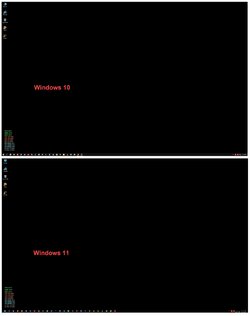Forgive me if I've simply missed this, but I've not seen this method mentioned. I was wondering if there is some negative to installing 22H2 like this that I am unaware of.
This method requires the following:
1) Works only if installing the Pro edition of Windows, not Home.
2) It does require an internet connection.
Detailed steps:
Begin installation as always and continue up to the point where you are asked "How would you like to set up this device?". Normally you would expect to choose the option "Set up for personal use". Don't choose this! Instead, select "Set up for work or school" and then click on "Next". Click on "Sign-in options". Select "Domain join instead". Don't worry, we will NOT be joining a domain!
From here on, the rest of the installation is just the same as it was in previous versions when creating a local account. You will be asked to enter a name, password, etc. and this results in a local account being created.
I know that there are other ways to accomplish this, but I was looking for something very specific and stumbled upon this in my testing.
My personal preference is to use an unattended answer file to automatically create a local user account without needing any network connection, but I thought that this result was still interesting.
This method requires the following:
1) Works only if installing the Pro edition of Windows, not Home.
2) It does require an internet connection.
Detailed steps:
Begin installation as always and continue up to the point where you are asked "How would you like to set up this device?". Normally you would expect to choose the option "Set up for personal use". Don't choose this! Instead, select "Set up for work or school" and then click on "Next". Click on "Sign-in options". Select "Domain join instead". Don't worry, we will NOT be joining a domain!
From here on, the rest of the installation is just the same as it was in previous versions when creating a local account. You will be asked to enter a name, password, etc. and this results in a local account being created.
I know that there are other ways to accomplish this, but I was looking for something very specific and stumbled upon this in my testing.
My personal preference is to use an unattended answer file to automatically create a local user account without needing any network connection, but I thought that this result was still interesting.
My Computers
System One System Two
-
- OS
- Win11 Pro 24H2
- Computer type
- PC/Desktop
- Manufacturer/Model
- Self-built
- CPU
- Intel i7 11700K
- Motherboard
- ASUS Prime Z590-A MB
- Memory
- 64GB (Waiting for warranty replacement of another 64GB for 128GB total)
- Graphics Card(s)
- No GPU - Built-in Intel Graphics
- Sound Card
- Integrated
- Monitor(s) Displays
- HP Envy 32
- Screen Resolution
- 2560 x 1440
- Hard Drives
- 1 x 1TB NVMe SSD
1 x 2TB NVMe SSD
1 x 4TB NVMe SSD
3 x 512GB 2.5" SSD
1 x 4TB 2.5" SSD
5 x 8TB Seagate Barracuda HDD
- PSU
- Corsair HX850i
- Case
- Corsair iCUE RGB 5000X mid tower case
- Cooling
- Noctua NF-S12A chromax.black.swap case fans (Qty. 7) & Home Computer Specifications, Configuration, and Usage Notes General Specifications ASUS Prime Z590-A motherboard, serial number M1M0KC222467ARP Intel Core i7-11700K CPU (11th Gen Rocket Lake / LGA 1200 Socket) 128GB Crucial Ballistix RGB DDR4 3200 MHz DRAM (4 x 32GB) Corsair iCUE RGB 5000X mid tower case Noctua NH-D15 chromax.black CPU cooler Noctua NF-S12A chromax.black.swap case fans (Qty. 7) & Corsair LL-120 RGB Fans (Qty. 3)
- Keyboard
- Corsair K70 Max RGB Magnetic Keyboard
- Mouse
- Logitech MX Master 3
- Internet Speed
- 1Gb Up / 1 Gb Down
- Browser
- Edge
- Antivirus
- Windows Defender
- Other Info
- The five 8TB drives and three 512GB SSDs are part of a DrivePool using StableBit DrivePool software. The three SSDs are devoted purely to caching for the 8TB drives. All of the important data is stored in triplicate so that I can withstand simultaneous failure of 2 disks.
Networking: 2.5Gbps Ethernet and WiFi 6e
-
- Operating System
- Win11 Pro 23H2
- Computer type
- Laptop
- Manufacturer/Model
- Lenovo ThinkBook 13x Gen 2
- CPU
- Intel i7-1255U
- Memory
- 16 GB
- Graphics card(s)
- Intel Iris Xe Graphics
- Sound Card
- Realtek® ALC3306-CG codec
- Monitor(s) Displays
- 13.3-inch IPS Display
- Screen Resolution
- WQXGA (2560 x 1600)
- Hard Drives
- 2 TB 4 x 4 NVMe SSD
- PSU
- USB-C / Thunderbolt 4 Power / Charging
- Mouse
- Buttonless Glass Precision Touchpad
- Keyboard
- Backlit, spill resistant keyboard
- Internet Speed
- 1Gb Up / 1Gb Down
- Browser
- Edge
- Antivirus
- Windows Defender
- Other Info
- WiFi 6e / Bluetooth 5.1 / Facial Recognition / Fingerprint Sensor / ToF (Time of Flight) Human Presence Sensor








